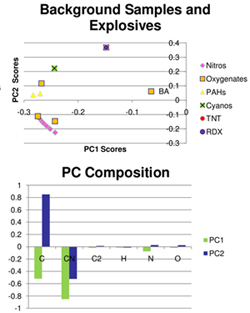Laser Induced Breakdown Spectroscopy (LIBS) is an analytical technique that can determine the elemental composition of a sample by gathering both atomic and molecular information in a single shot. The emission collected by LIBS is complex in nature, and consists of a mixture of the laser, the sample, and the atmosphere. This complexity is further complicated due to the fact that the organic samples contain some of the same constituents as that of the atmosphere. As such caution must be taken when assigning the emitters.
This study makes a comparison of single shot LIBS emission from the molecular and atomic species from plasmas produced from organic thin film residues on a silicon substrate. The characterization is based on the atomic carbon, hydrogen, nitrogen, and oxygen peaks as well as the diatomic species CN violet bands and the C2 swan bands. The organic samples analyzed have varying amounts of carbon, nitrogen, hydrogen and oxygen in their molecular structure, and in order to discriminate between these organic samples chemometrics is utilized. More specifically, we use Principle Component Analysis (PCA) to identify similarities of the organic analyte via the emission,1,2 and Receiver Operator Characteristic (ROC) curves to measure the performance of discrimination of different organic materials.

